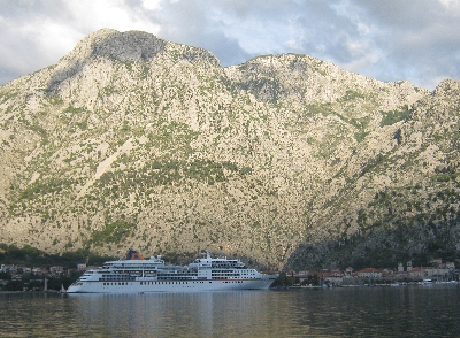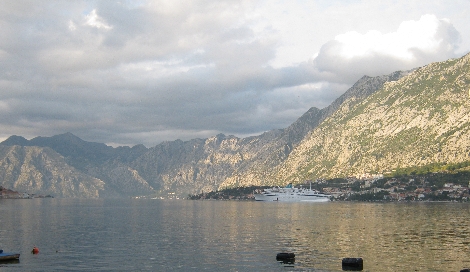
In the south-western corner of Montenegro, not far from the border with Croatia, lies the fascinating Bay of Kotor. It is often described as the most southerly fjord in Europe which the geographer in me immediately wants to dispute! Fjords are the result of glaciation whereas the Bay of Kotor is a submerged river valley. However, with the whole of the sea inlet surrounded by steep-sided mountains it is very similar in appearance to a fjord.
The historic walled town of Kotor lies at the southern extremity of the bay. As can be seen in my photograph

on the left, it is increasingly visited by large cruise ships which seem to tower over everything except the surrounding mountains. The twin towers of Kotor Cathedral on the right look miniscule compared to the multiple decks of the cruise ship.
Having reached Kotor via a road tunnel from the coast road under the surrounding mountains, we headed along the shore of the bay to the village of Prcanj, about 3 km from Kotor itself. Here we found the very pleasant and reasonably priced Hotel Bokeljski Dvori where we stayed for the next two nights. Their rate for bed and breakfast was half that of Hotel Kato in Podgorica and, in answer to our enquiry, they assured that coffee was included in the price of breakfast. We did get a rather puzzled look from the lady at the reception desk when we asked about coffee being included, until we explained about our experience the previous night in Podgorica!

The next morning, we returned to Kotor, managed to find a space to park the car on the harbour side, and set out on foot to explore the walled town. Located in a small square in the centre of the old town is St. Tryphon’s Cathedral. As can be seen from the dates on the twin bell towers, the Cathedral has just celebrated 1,200 years of Christian worship. There is very little left of the original 9th century building – most of the current building dates from the 12th century. The twin bell towers are more recent being baroque in style and date from the re-building of the west front of the Cathedral following earthquake damage in 1667.
The Cathedral belongs to the Roman Catholic Church, this corner of Montenegro having a significant Catholic population as well as many Orthodox Christians. The building itself had been beautifully restored for the 1,200th anniversary celebrations earlier in the year. Within the Cathedral there was a photographic display of the various celebratory events that had taken place.
As we wandered around exploring other parts of the historic walled town, we regularly had to find shelter from increasingly heavy rain showers. We did manage to eat lunch outside but only because of the shelter provided by a large awning over the restaurant table.

After lunch, we set out in the car to explore further around the shores of the Bay of Kotor. We drove to the village of Perast which overlooks the narrow entrance channel that leads from the Adriatic Sea into the bay. The main Church of St. Nicholas has an amazingly tall bell tower with architecture that is very Venetian in style, reflecting the past history of the area. In the square in front of the Church, a French film crew were trying to film an outdoor sequence but were struggling with the increasingly inclement weather.
Much as I would have loved to explore further along around the shore of the bay, we reluctantly decided that the wet and stormy weather precluded us from doing so. We therefore retraced our steps and returned to the shelter and warmth of our hotel in Prcanj.
Overnight, the weather became extremely stormy with very strong winds and heavy rain, as a large depression made its way across the Adriatic Sea from Italy, into the Balkans.
|
|


Another part of the world I know nothing about. Thanks for sharing!
.-= Karen´s last blog ..American Mistletoe Growers are Leaving Money on the Table =-.
Karen,
I hope you do get the chance to visit it someday. I think you would find it awesome.
Stunning views, Ricky. So that’s what a fjord is – thanks for enlightenment! This landscape’s a little like the calanques to the east of Marseille, but on a much grander scale.
.-= Minnie´s last blog ..Tricks of confidence =-.
Minnie – Both the calanques and the Bay of Kotor are flooded river valleys which took their current form at the end of the last ice age as glaciers retreated and melted and, as a consequence, sea levels rose. A fjord is the direct result of glaciation being gouged out by a glacier moving down the valley. Here endeth the Physical Geography lesson!!!
Thanks for the physical geography lesson, Ricky! Always pleased to learn more about such things, as am complete ignoramus (and NOT proud of it!).
.-= Minnie´s last blog ..A free rein for escapism =-.
Thank you so much for not referring to Kotor Bay as Kotor Fjord like everyone else does! I discovered the same a couple of years ago, and feel quite evangelical about it. The term for a flooded river valley is a “ria” which to me sounds beautiful. The Kotor Ria – now that sounds like a place to visit!
Andrea – Yes, Kotor Bay is a ‘ria’. I did know the correct term but wasn’t sure that if I used it, many of my readers would have known what I meant so I used the descriptive ‘flooded river valley’ instead. And certainly, the Kotor Ria is a place to visit and re-visit.
I simply love the stunning sites. I haven’t been there but it seems like I definitely need to see this place in real life.